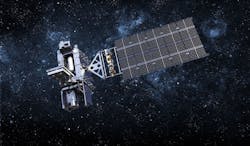NASA to release solicitation this fall for hyperspectral sensors payloads for Earth-observation satellites
GREENBELT, Md. – U.S. space agency researchers are making plans to ask industry to develop a space-based hyperspectral infrared instrument to fly on the Geostationary Extended Observations (GeoXO) series of geostationary Earth-observation satellites.
Officials of the National Aeronautics and Space Administration (NASA) Goddard Space Flight Center announced plans Monday to issue a request for proposals (RF) for implementation of the GeoXO Atmospheric Composition (ACX) instrument.
This is a new instrument for the GeoXO program will be a hyperspectral ultraviolet-through-visible-imaging spectrometer to measure environmental data as part of a 3-axis stabilized geostationary weather satellite system.
The ACX remotely collects imagery of the superregional area for national air quality forecasting, hazard forecasting, and fire pollutant forecasting and warnings.
Hyperspectral imaging involves slicing an image into many different spectral bands to uncover details that otherwise might be hidden. This presents a formidable digital signal processing challenge, which is compounded when the dimension of time is added.
NASA Goddard will ask industry to design and build the ACX sensors payload, support its launch, supply and maintain the instrument ground support equipment, and support mission operations at the National Oceanic and Atmospheric Administration (NOAA) Satellite Operations Facility (NSOF) in Suitland, Md.
NASA officials say they expect to ask industry to build two ACX sensors flight models, with an option for an additional spare flight model. The base contract will ask industry to build, deliver, integrate, and support one flight model and parts for a second flight model.
The base contract also will call for engineering development units for instrument subassemblies and an integrated engineering development model, if proposed. Option 1 will be the build for flight models and option 2 will be parts and building of a flight model spare.
Option 2 includes parts, assembly and test for the flight model spare that will be delivered and stored until the launch of flight model 2.
The anticipated period of performance for this contract includes support for 10 years of on-orbit operations and five years of on-orbit storage, for a total of 15 years for each flight model. A draft RFP is expected in July, and a final RFP is expected in September. The anticipated contract award date is April 2024.
Companies interested should notify NASA's Tracey Jones of their intentions to submit offers by email at [email protected]. Email questions no later than 6 June 2023 to Tracey Jones at [email protected]. More information is online at https://sam.gov/opp/01e27236d2144c6e9a7ba5a7035c535a/view.
About the Author
John Keller
Editor-in-Chief
John Keller is the Editor-in-Chief, Military & Aerospace Electronics Magazine--provides extensive coverage and analysis of enabling electronics and optoelectronic technologies in military, space and commercial aviation applications. John has been a member of the Military & Aerospace Electronics staff since 1989 and chief editor since 1995.
